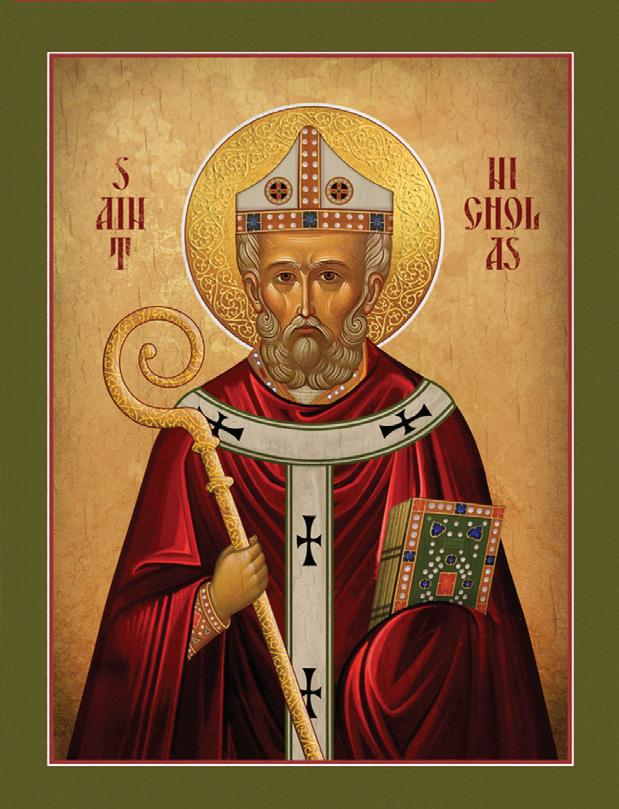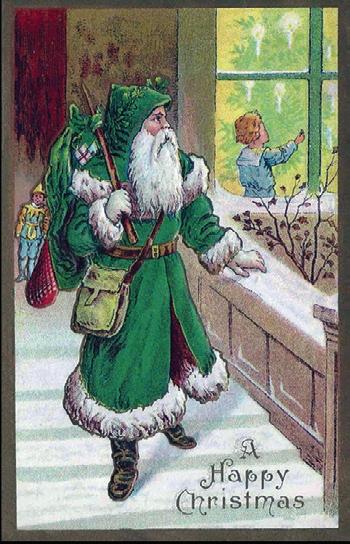

















































By Robert Matsumura, Active Media
As the holiday season rolls around, Santa Claus assumes center stage. But where exactly did this rotund, jovial old man in a red suit originate, and how did he become the iconic symbol of Christmas that he is today? In truth, the history of Santa Claus is a fascinating tale that intertwines folklore, legends and a sprinkle of entrepreneurial ingenuity.
Santa Claus as we know him today traces his roots back to a number of historical figures, each contributing to the contemporary version we know and love. Perhaps the earliest inspiration for Santa Claus was Saint Nicholas, a Christian bishop of the 4th century, renowned for his acts of kindness and gift-giving. In time, Saint Nicholas became the patron saint of children, sailors, merchants, archers and brewers, among others.
In the British Isles, a character known as Father Christmas emerged during the mid-17th century and was frequently depicted as a bearded man garbed in green, symbolizing the spirit of the season. By the 18th century, however, the concepts of Father Christmas and Saint Nicholas merged, resulting in a hybrid figure that blended elements from both traditions.

The American version of Santa Claus began to take shape in the 18th century. Influenced by Dutch and German settlers, the name “Santa Claus” evolved from the Dutch term “Sinterklaas.”
During this period, “A Visit from St. Nicholas” (commonly known as “The Night Before Christmas”), a poem published in 1823, played a pivotal role in shaping the modern image of Santa. This poem described Santa


as a rotund gift-giver in a red suit who utilized chimneys rather than the front door for his Christmas visits. The poem, attributed to Clement Clarke Moore, established not only Santa’s magical nighttime journey around the world delivering toys to children, but specified his vehicle of choice as a sleigh powered by eight reindeer with specific names and attributes. Also introduced in the poem was the idea of Santa monitoring children on his “naughty and nice” list and filling stockings accordingly.
The classic image of Santa Claus in a red suit with a white beard was tweaked further in the 1930s due to a marketing campaign by Coca-Cola. The company’s advertisements depicted Santa as plump, rosy-cheeked, and garbed in a red and white outfit and hat. Although Santa had been portrayed in robes of other colors prior to this marketing campaign, CocaCola’s version of Santa Claus was embraced by the popular imagination and remains the image we associate with him to this day.

As the holidays roll around, and images of Santa Claus abound, know that, like so many things in life, Santa has evolved from his ancient origins as Saint Nicholas and Father Christmas to the iconic figure of Christmas cheer crafted by an imaginative poet and creative corporate advertising. One thing is for certain, whether you’re a child or an adult, the holidays would not be the same without Santa, his reindeer and the spirit of the season that he represents to so many around the world!



By Patti Jo Brooks, Active Media
Patio Cover People, a Wilsonville company operated by owners Tom Moore and Chris McReynolds, love to serve the community. The two are local through and through. Best friends since before kindergarten, they grew up in Tualatin and lived just a couple miles away from each other. Their entrepreneurial adventures began early with a lawn mowing business in junior high, followed by house painting in high school. They went to different colleges, but after graduation they each got married and ended up moving back to Wilsonville and lived right across the street from each other.
Tom spent the first half of his professional career as a software engineer while Chris went into operations and business management. In 2012, they worked together and connected again, this time as senior executives of a health technology company in Clackamas. Then, in September 2021, they traded the digital health space for outdoor living
and bought Patio Cover People — the largest and longest serving patio cover company in the Pacific Northwest. Since taking over, they’ve instilled a customer-first mindset into the business with the goal of creating a service-based business that stands apart from the typical contractor in the industry. It may sound trite, but if you call, they will answer the phone. If you email, it will get answered. If you have them out, they will actually give you a written estimate right on the spot. They tout their “ridiculous responsiveness” as a huge differentiator in the construction world.
So what is Patio Cover People all about? Patio Cover People installs high-quality daylight patio covers with optional railings and shades. If you need a deck or want to enclose the patio cover into a full room, they can do that as well. One advantage Patio Cover People offers is the acrylic material used for their patio covers, which allows more daylight to penetrate under the patio cover as well as into your home. This can be especially nice in the Northwest with its numerous overcast days. And for those sunny summer days, these acrylic covers reflect about 3/4 of the heat away, which in turn creates a more comfortable environment year-round. There are two styles of patio covers to choose from, shed and gable. The shed-style is a simple design that slopes downward off the house in a lean-to fashion, whereas the gable-style with its upward peak provides greater visibility for a property with a view. The gable-style, particularly when coupled with an enclosure, offers an appealing aesthetic that certain clients prefer.
Patio Cover People aims to give people a better outdoor living experience. Common situations clients seek to resolve are environments that are too wet, too hot, too small, too muddy from pets tracking into the house, or they’re simply ready to upgrade their patio area. Patio Cover People takes great pride in their work and expertise. As owner Tom puts it, “We solve problems and make it better.”
The company’s brand is fun and laid back – like an evening on the patio with family and friends – but this team is very serious about what they do. And they do it well. In fact, they have a long list of past clients who became “patio cover people” and have volunteered to be contacted by prospective customers who are considering a daylight patio cover. (Many of them will even invite people over to check it out for themselves!) And that speaks to the high level of trust and satisfaction that Tom and Chris have built with their customers.
Patio Cover People services the Greater Portland Metro Area and beyond — stretching north to Longview, Washington, and southward to Eugene and Springfield. Their clients give them rave reviews for their products, installation and service. So give them a call and you and your family can become patio cover people!
Patio Cover People is located at 10965 SW Commerce Circle in Wilsonville. Visit their website at patiocoverpeople.com or call them at (971) 351-3317.







OREGON BLACK HISTORY SPOTLIGHT: THELMA JOHNSON STREAT
By Oregon Black Pioneers
Thelma Johnson Streat was a painter and dancer who used her art to promote racial equity and education. Thelma Beatrice Johnson was born in 1911 or 1912 in the Eastern Washington town of Yakima. The Johnson family moved several times during Thelma’s childhood, with stints in Pendleton and Boise before settling permanently in Portland by 1920. Her father, James Johnson, was an artist and encouraged Thelma to become an artist herself from an early age. While still in high school, Thelma began winning local art prizes. She graduated from Portland’s Washington High School in 1932 and immediately launched her career as a professional artist.
In 1933, the Oregon Federation of Colored Women had an art exhibit at the New York Public Library. Several of Johnson’s works were featured in the show, and the exhibit gave her new exposure within the broader American art community. Johnson studied painting at Portland’s Museum Art School (today known as the Pacific Northwest College of Art) from 1934-1935, and at the University of Oregon in 1936.

In 1935, Thelma married Romaine Virgil Streat, a boxer who modeled for her drawing class. The couple moved to San Francisco where Thelma found work with the Federal Art Project, a Depression-era relief program for artists. Thelma’s work attracted the attention of acclaimed painter Diego Rivera, who she collaborated with on a mural for the 1939 Golden Gate Exposition. Rivera would write, “The work of Thelma Johnson Streat is in my opinion one of the most interesting manifestations in this country at the present. It is extremely evolved and sophisticated enough to reconquer the grace and purity of African and American art.” Rivera even painted Johnson into one of his own murals, which is today on the City College of San Francisco campus.
Thelma continued to grow as a solo artist. Her paintings were exhibited at San Francisco’s De Young Museum and the San Francisco Museum of Art. One of her works, Rabbit Man, was purchased by New York’s Museum of Modern Art in 1941, making it the first piece by a Black woman included in their permanent collection.

Thelma used her art to promote racial equality. Works like her “Death of a Negro Sailor” criticized segregation, and she debuted a series of paintings called “The Negro History” depicting prominent people of African descent from the past. She also began practicing interpretive dance in the 1940s, performing around the world for dignitaries like Eleanor Roosevelt and Queen Elizabeth II.
In 1948, Thelma divorced her husband and married her manager, John Kline. Thelma and John moved to Hawaii and opened a children’s art school. They later opened another on Salt Spring Island in British Columbia. Here, Thelma taught her students art and dance inspired by African, Polynesian and First Nations traditions.
Thelma enrolled at UCLA to study anthropology in 1956, but suffered a heart attack and died there that same year. Her brief but prolific career was largely forgotten in the decades that followed. Today, Thelma is finally being recognized as one of the most important West Coast artists of the early 20th century. Paintings by Thelma are today part of the collections of the Museum of Modern Art, San Francisco Museum of Art, Portland Art Museum, and the National Museum of African American History and Culture.
Oregon Black Pioneers is Oregon’s only historical society dedicated to preserving and presenting the experiences of African Americans statewide. To learn more, and to support this nonprofit, visit oregonblackpioneers.org.
©Oregon Black Pioneers, 2024













By Robert Matsumura, Active Media
Every year around December 21st in the Northern Hemisphere, the winter solstice occurs, marking the shortest day and longest night of the year. Through the centuries this annual cosmic event has inspired stories, myths, and celebrations, blending elements of nature, light, and spirituality in traditions shared by numerous cultures across the globe. At the heart of these ancient rituals and festivities is the summer solstice’s association with birth and renewal, a seasonal change in nature that heralds the coming of spring and an end to the darkness of winter.
Before calendars and clocks were invented, people lived in accordance with the sun’s cycles. In a sun-centric world the solstice served as a pivotal marker in their agricultural, spiritual, and social lives. For many cultures, the winter solstice was viewed with trepidation — a time when the world could fall into chaos, a dark period where the sun was symbolically at its weakest — before returning to glory as the days lengthened. The summer solstice was a reminder of the sun’s return, bringing warmth, growth, and sustenance. Elaborate feasts were often held, sacred rituals performed, and fires lit to encourage the rebirth of the sun.

One of the most famous winter solstice traditions took place in Northern Europe where ancient Germanic and Norse tribes celebrated Yule. A festival that honored the Norse gods, particularly Odin, Yule focuses upon the rebirth of the sun. Evergreens, symbolizing eternal life, were central to Yule, and homes were decorated with boughs of holly, ivy, and mistletoe — plants resistant to winter’s chill. Over time, these traditions blended with Christian customs, resulting in today’s wreaths, garlands, and Christmas trees.
Across the Roman Empire, the solstice celebration known as Saturnalia was a time of joyous revelry. Saturnalia honored Saturn, the god of agriculture and time with festivities that flipped societal norms. During Saturnalia, carnivallike chaos reigned — slaves could become masters for a day, gambling was permitted, and everyone feasted. It was a season of merriment, gift-giving, and the relaxation of social rules. Everyone — rich and poor alike — could partake in the festivities. Saturnalia had a profound influence on later Christmas celebrations, particularly the communal feasting, exchanging of gifts, and sense of goodwill.
The British Isles: Stonehenge and the Celtic Solstice

In East Asia, the Dongzhi Festival signals the arrival of winter and the rebirth of yang energy. Dongzhi, meaning “extreme of winter,” derives from the concept of yin and yang — the cosmic balance of dark and light. While the winter solstice represents the darkest day, it also signifies the gradual rise of yang energy and the light.
In the British Isles, Stonehenge remains one of the most iconic sites associated with the winter solstice. Constructed thousands of years ago, this mysterious stone circle aligns perfectly with the solstice sunrise, drawing crowds of onlookers annually to witness the event. Though Stonehenge’s origin is unknown, it’s clear that its creators were deeply attuned to the celestial rhythms, and utilized the monument to mark important seasonal shifts.
In the Celtic world, the summer solstice was a time when the Oak King triumphed over the Holly King in their eternal battle for earth’s light. The Oak King, symbolizing the waxing sun, would begin to grow stronger with the longer days, heralding the return of spring. Rituals involved bonfires, feasts, and offerings to the gods in gratitude for the return of the light.
In China, Dongzhi is a time for family reunions and feasting on specific culinary favorites such as tangyuan — glutinous rice balls served in sweet syrup, symbolizing family unity. In southern China, dumplings are also popular and are believed to protect against the winter cold. Dongzhi is also a time for reconnecting with ancestors, and the belief is that one’s good fortune and health in the coming year depends on harmony between the living and the deceased.
For many Indigenous cultures of North America, summer solstice rituals were held to celebrate the return of the sun. The Pueblo peoples celebrated Soyal with purification rituals and dances meant to awaken the sun from its winter sleep. Central to the ceremony is the creation of kachina dolls — symbolic representations of deities or spirits — that play a crucial role in the life cycle.
Far to the North, the Inuit people of Alaska and Canada honored the summer solstice with a festival called Quviasukvik, a time when families convened to share food and stories, reflect on the past and anticipate the return of the sun. As a people accustomed to harsh Arctic winters, the summer solstice indeed was cause for celebration. Longer days and the return of the sun literally represented survival in the brutal conditions of the North.
In the Southern Hemisphere, the summer solstice occurs in June. Among the Incas, Inti Raymi, the festival of the sun was held in honor of Inti, the sun god. The Incas, who revered the sun as their primary deity, performed elaborate ceremonies in honor of Inti to ensure good harvests in the coming year. At the heart of the solstice celebrations was the city of Cusco, where ritual sacrifices, offerings and dances were performed to demonstrate the people’s gratitude and reverence for the sun’s critical role in sustaining life. Modern day celebrations honoring Inti are held to this day.
While solstice celebrations have evolved over the centuries, themes of light, rebirth, and reflection are timeless. From spiritual gatherings to cozy times around the hearth, the winter solstice invites us to anticipate the return of the sun and all that it brings to the earth. So as the winter solstice rolls around, take a moment to slow down, reflect, and find balance, like our ancestors once did. On the darkest of days, the solstice is a celebration of endurance, hope, and abundance that light makes possible in our lives.





















